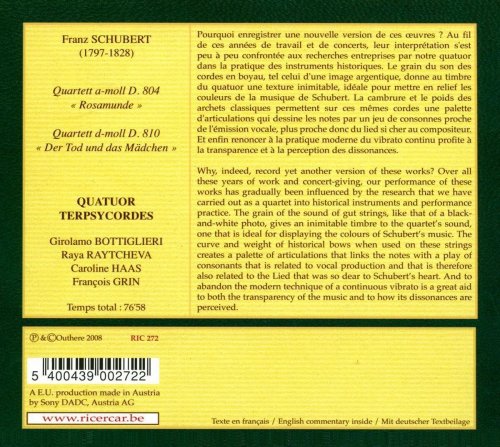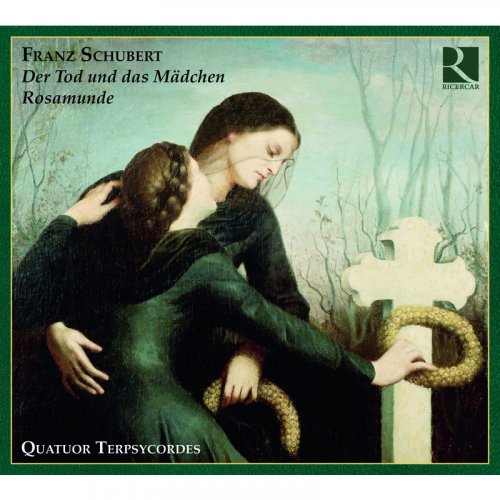
Quatuor Terpsycordes - Franz Schubert: Der Tod und das Mädchen & Rosamunde (2008)
BAND/ARTIST: Quatuor Terpsycordes
- Title: Franz Schubert: Der Tod und das Mädchen & Rosamunde
- Year Of Release: 2008
- Label: Ricercar
- Genre: Classical
- Quality: flac lossless
- Total Time: 01:16:56
- Total Size: 344 mb
- WebSite: Album Preview
Tracklist
01. Quartett No. 13 in A-Moll, D. 804 "Rosamunde": I. Allegro ma non troppo
02. Quartett No. 13 in A-Moll, D. 804 "Rosamunde": II. Andante
03. Quartett No. 13 in A-Moll, D. 804 "Rosamunde": III. Menuetto (Allegretto)
04. Quartett No. 13 in A-Moll, D. 804 "Rosamunde": IV. Allegro moderato
05. Quartett No. 14 in D-Moll, D. 810 "Der Tod und das Mädchen": I. Allegro
06. Quartett No. 14 in D-Moll, D. 810 "Der Tod und das Mädchen": II. Andante con moto
07. Quartett No. 14 in D-Moll, D. 810 "Der Tod und das Mädchen": III. Scherzo (Allegro molto)
08. Quartett No. 14 in D-Moll, D. 810 "Der Tod und das Mädchen": IV. Presto

Why, indeed, record yet another version of these works? Rosamunde and Der Tod und das Mädchen have figured in our repertoire for as long as we have been playing together, first as works we dreamt about, then as pieces that we discovered and then experienced. Over all these years of work and concert-giving, our performance of these works has gradually been influenced by the research that we have carried out as a quartet into historical instruments and performance practice. The grain of the sound of gut strings, like that of a black-and-white photo, gives an inimitable timbre to the quartet's sound, one that is ideal for displaying the colours of Schubert's music. The curve and weight of historical bows when used on these strings creates a palette of articulations that links the notes with a play of consonants that is related to vocal production and that is therefore also related to the Lied that was so dear to Schubert's heart. And to abandon the modern technique of a continuous vibrato is a great aid to both the transparency of the music and to how its dissonances are perceived. Our interpretations often take the instruments themselves as their base; our wish as a quartet is to reveal the infinite beauty and complexity of these compositions to the best of our knowledge and ability.
The Quatuor Terpsycordes
For this recording, the Quatuor Terpsycordes performs on four instruments made by the Vuillaume studio of luthiers that have kindly been made available for the quartet's use by the Musée d'Art et d'Histoire in Geneva. They use two violins by Jean-Baptiste Vuillaume, the first being a mid-19th century copy of a Guarnerius del Gesù and the second being a copy of the Stradivarius Messiah made in Paris in 1864. The viola is also attributed to Jean-Baptiste Vuillaume and is a copy of a del Gesù. The cello, an exact copy of the Servais Stradivarius, is the work of Nicolas-François Vuillaume, the brother of Jean-Baptiste and was made in Brussels in 1861. The instruments have been prepared for historical performance with gut strings and have been tuned for this recording to A=430 Hz. Bow maker Bruno Sporcq has constructed four ‘classical' bows for the quartet, taking his inspiration from bows made in England by Dodd at the end of the 18th century.
01. Quartett No. 13 in A-Moll, D. 804 "Rosamunde": I. Allegro ma non troppo
02. Quartett No. 13 in A-Moll, D. 804 "Rosamunde": II. Andante
03. Quartett No. 13 in A-Moll, D. 804 "Rosamunde": III. Menuetto (Allegretto)
04. Quartett No. 13 in A-Moll, D. 804 "Rosamunde": IV. Allegro moderato
05. Quartett No. 14 in D-Moll, D. 810 "Der Tod und das Mädchen": I. Allegro
06. Quartett No. 14 in D-Moll, D. 810 "Der Tod und das Mädchen": II. Andante con moto
07. Quartett No. 14 in D-Moll, D. 810 "Der Tod und das Mädchen": III. Scherzo (Allegro molto)
08. Quartett No. 14 in D-Moll, D. 810 "Der Tod und das Mädchen": IV. Presto

Why, indeed, record yet another version of these works? Rosamunde and Der Tod und das Mädchen have figured in our repertoire for as long as we have been playing together, first as works we dreamt about, then as pieces that we discovered and then experienced. Over all these years of work and concert-giving, our performance of these works has gradually been influenced by the research that we have carried out as a quartet into historical instruments and performance practice. The grain of the sound of gut strings, like that of a black-and-white photo, gives an inimitable timbre to the quartet's sound, one that is ideal for displaying the colours of Schubert's music. The curve and weight of historical bows when used on these strings creates a palette of articulations that links the notes with a play of consonants that is related to vocal production and that is therefore also related to the Lied that was so dear to Schubert's heart. And to abandon the modern technique of a continuous vibrato is a great aid to both the transparency of the music and to how its dissonances are perceived. Our interpretations often take the instruments themselves as their base; our wish as a quartet is to reveal the infinite beauty and complexity of these compositions to the best of our knowledge and ability.
The Quatuor Terpsycordes
For this recording, the Quatuor Terpsycordes performs on four instruments made by the Vuillaume studio of luthiers that have kindly been made available for the quartet's use by the Musée d'Art et d'Histoire in Geneva. They use two violins by Jean-Baptiste Vuillaume, the first being a mid-19th century copy of a Guarnerius del Gesù and the second being a copy of the Stradivarius Messiah made in Paris in 1864. The viola is also attributed to Jean-Baptiste Vuillaume and is a copy of a del Gesù. The cello, an exact copy of the Servais Stradivarius, is the work of Nicolas-François Vuillaume, the brother of Jean-Baptiste and was made in Brussels in 1861. The instruments have been prepared for historical performance with gut strings and have been tuned for this recording to A=430 Hz. Bow maker Bruno Sporcq has constructed four ‘classical' bows for the quartet, taking his inspiration from bows made in England by Dodd at the end of the 18th century.
As a ISRA.CLOUD's PREMIUM member you will have the following benefits:
- Unlimited high speed downloads
- Download directly without waiting time
- Unlimited parallel downloads
- Support for download accelerators
- No advertising
- Resume broken downloads


